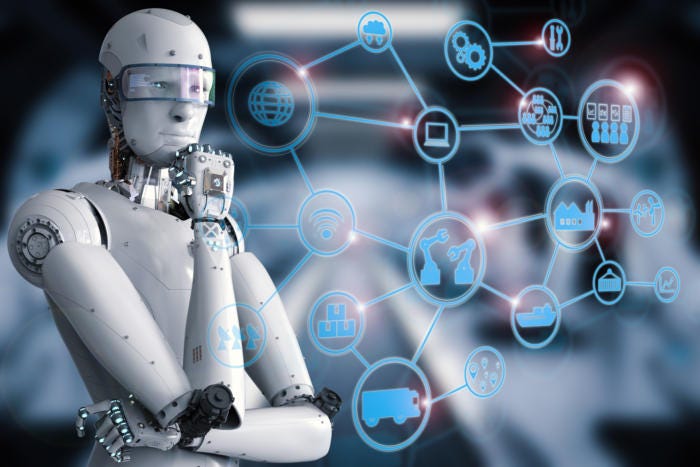Robotics Vs. Artificial Intelligence: What is the difference?

Is robotics part of AI? Is AI part of robotics? What is the difference between the two terms? We answer this fundamental question.
Robotics and artificial intelligence serve very different purposes. However, people often get them mixed up. A lot of people wonder if robotics is a subset of artificial intelligence or if they are the same thing.
Let’s put things straight.

Are Robotics and Artificial Intelligence the Same Thing?
The first thing to clarify is that robotics and artificial intelligence are not the same thing at all. In fact, the two fields are almost entirely separate.
A Venn diagram of the two would look like this:

I guess that people sometimes confuse the two because of the overlap between them: Artificially Intelligent Robots.
To understand how these three terms relate to each other, let’s look at each of them individually.
What Is Robotics?
Robotics is a branch of technology which deals with robots. Robots are programmable machines which are usually able to carry out a series of actions autonomously, or semi-autonomously.
In my opinion, there are three important factors which constitute a robot:
- Robots interact with the physical world via sensors and actuators.
- Robots are programmable.
- Robots are usually autonomous or semi-autonomous.
I say that robots are “usually” autonomous because some robots aren’t. Telerobots, for example, is entirely controlled by a human operator but telerobotics is still classed as a branch of robotics. This is one example where the definition of robotics is not very clear.
It is surprisingly difficult to get experts to agree exactly what constitutes a “robot.” Some people say that a robot must be able to “think” and make decisions. However, there is no standard definition of “robot thinking.” Requiring a robot to “think” suggests that it has some level of artificial intelligence.
However you choose to define a robot, robotics involves designing, building and programming physical robots. Only a small part of it involves artificial intelligence.
What Is Artificial Intelligence?
Artificial intelligence (AI) is a branch of computer science. It involves developing computer programs to complete tasks which would otherwise require human intelligence. AI algorithms can tackle learning, perception, problem-solving, language-understanding and/or logical reasoning.
AI is used in many ways within the modern world. For example, AI algorithms are used in Google searches, Amazon’s recommendation engine and SatNav route finders. Most AI programs are not used to control robots.
Even when AI is used to control robots, the AI algorithms are only part of the larger robotic system, which also includes sensors, actuators and non-AI programming.
Get practical knowledge of AI at AI Online Training
Often — but not always — AI involves some level of machine learning, where an algorithm is “trained” to respond to a particular input in a certain way by using known inputs and outputs.
The key aspect that differentiates AI from more conventional programming is the word “intelligence.” Non-AI programs simply carry out a defined sequence of instructions. AI programs mimic some level of human intelligence.
What Are Artificially Intelligent Robots?
Artificially intelligent robots are the bridge between robotics and AI. These are robots which are controlled by AI programs.
Many robots are not artificially intelligent. Up until quite recently, all industrial robots could only be programmed to carry out a repetitive series of movements. As we have discussed, repetitive movements do not require artificial intelligence.
Non-intelligent robots are quite limited in their functionality. AI algorithms are often necessary to allow the robot to perform more complex tasks.
Let’s look at some examples.
Example: Non-Artificially Intelligent Cobot
A simple collaborative robot (cobot) is a perfect example of a non-intelligent robot.
For example, you can easily program a cobot to pick up an object and place it elsewhere. The cobot will then continue to pick and place objects in exactly the same way until you turn it off. This is an autonomous function because the robot does not require any human input after it has been programmed. However, the task does not require any intelligence.
Example: Artificially Intelligent Cobot
You could extend the capabilities of the cobot by using AI.
Imagine you wanted to add a camera to your cobot. Robot vision comes under the category of “perception” and usually requires AI algorithms.
For example, say you wanted the cobot to detect the object it was picking up and place it in a different location depending on the type of object. This would involve training a specialized vision program to recognize the different types of object. One way to do this is using an AI algorithm called Template Matching, which we discuss in our article How Template Matching Works in Robot Vision.
Know more on AI robots at Artificial Intelligence Online Training
Conclusion and a Confusion: Software Robots
As you can see, robotics and artificial intelligence are really two separate things. Robotics involves building robots whereas AI involves programming intelligence.
However, I leave you with one slight confusion: software robots.
“Software robot” is the term given to a type of computer program which autonomously operates to complete a virtual task. They are not physical robots, as they only exist within a computer. The classic example is a search engine web crawlers which roams the internet, scanning websites and categorizing them for search. Some advanced software robots may even include AI algorithms. However, software robots are not part of robotics.
